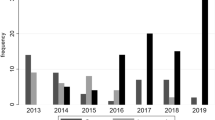Abstract
Purpose
Adoption of robotic retroperitoneal surgery has lagged behind robotic surgery adoption in general due to unique challenges of access and anatomy. We evaluated our initial results with robotic retroperitoneal robotic partial nephrectomy (RRPN) after transitioning from exclusively transperitoneal robotic partial nephrectomy (TRPN) to evaluate safety and any identifiable learning curve.
Methods
We evaluated our single-surgeon (RA) prospective partial nephrectomy database since adopting RRPN routinely for posterior tumors in 2017. The surgeon had previously performed 410 partial nephrectomies by this time. Outcomes were compared after the initial 30 RRPN.
Results
Of 137 patients since adopting RRPN, two attempted RRPN were converted to TRPN without complications due to morbid obesity affecting access, and 30 RRPN were completed (107 TRPN). There were no statistically significant differences in demographics, mean tumor size, or RENAL score between groups. Mean blood loss was lower in RRPN (53 mL vs 99 mL, P < 0.05), but there were no transfusions in either group. There was no difference in mean operative (127.8 min vs 141.2 min, P = 0.06) or ischemia time (11.1 min vs 10.8 min, P = 0.98). There were no positive margins in either group. Mean length of stay was lower in RRPN due to more same-day discharges (0.7 vs 0.9 days). There were no 90-day Clavien III–V complications. One RRPN patient was readmitted POD#8 overnight for hypoxia, and one visited the emergency room POD#7 for persistent pain. All three TRPN complications were managed as outpatients.
Conclusions
Successful adoption of RRPN can be achieved readily after experience with TRPN. Outcomes were immediately comparable without any identifiable learning curve.
Similar content being viewed by others
Abbreviations
- RRPN:
-
Retroperitoneal robotic partial nephrectomy
- TRPN:
-
Transperitoneal robotic partial nephrectomy
- TP:
-
Transperitoneal
- RP:
-
Retroperitoneal
- WIT:
-
Warm ischemia time
- eGFR:
-
Estimated glomerular filtration rate
- LOS:
-
Length of stay
- EBL:
-
Estimated blood loss
- OT:
-
Operative time
- BMI:
-
Body mass index
- ASA:
-
American society anesthesiologist
- IQR:
-
Interquartile range
References
Arora S, Heulitt G, Menon M et al (2018) Retroperitoneal vs transperitoneal robot-assisted partial nephrectomy: comparison in a multi-institutional setting. Urology 120:131–137
Choo S, LeeSY SunHH et al (2014) Transperitoneal versus retroperitoneal robotic partial nephrectomy: matched pair comparisons by nephrometry scores. World J Urol 32:1523–1529
Hughes-Hallett A, Patki P, Patel N, Barber NJ et al (2013) Robot-assisted partial nephrectomy: a comparison of the transperitoneal and retroperitoneal approaches. J Endourol 27:869–874
Omidele OO, Davoudzadeh N, Palese M (2018) Trifecta outcomes to assess learning curve of robotic partial nephrectomy. JSLS 22:1
Marconi L, Challacombe B (2018) Robotic partial nephrectomy for posterior renal tumors: retro or transperitoneal approach? Eur Urol Focus 4:632–635
Novara G, La Falce S, Kungulli A et al (2016) Robot assisted partial nephrectomy. Int J Surg 36:554–559
Feliciano J, Stifelman M (2012) Robotic retroperitoneal partial nephrectomy: a four-arm approach. JSLS 16:208–211
Stroup SP, Hamilton ZA, Marshall MT et al (2017) Comparison of retroperitoneal and transperitoneal robotic partial nephrectomy for Pentafecta perioperative and renal functional outcomes. World J Urol 35:1721–1728
Tanaka K, Shigemura K, Furukawa J et al (2013) Comparison of the trans peritoneal and retroperitoneal approach in robot assisted partial nephrectomy in an initial case series in Japan. J Endourol 27:1384–1388
Larcher A, Muttin F, Peyronnet B et al (2019) The learning curve for robot-assisted partial nephrectomy: impact of surgical experience on perioperative outcomes. Eur Urol 75:253–256
Pavan N, Derweesh I, Hampton LJ et al (2018) Retroperitoneal robotic partial nephrectomy: systematic review and cumulative analysis of comparative outcomes. J Endourol 32:591–596
Zhang Z, Zhao J, Dong W et al (2016) Acute kidney injury after partial nephrectomy: role of parenchymal mass reduction and ischemia and impact on subsequent functional recovery. Eur Urol 69:745–752
Mir MC, Autorino R, Porpiglia F (2018) Ischemia time and beyond: the concept of global renal damage. Minerva Urol Nefrol 70:447–449
Antonelli A, Cindolo L, Sandri M et al (2019) Predictors of the transition from off to on clamp approach during ongoing robotic partial nephrectomy: data from the clock randomized clinical trial. J Urol 202:62–68
Cindolo L, Antonelli A, Sandri M et al (2019) The role of vascular clamping during robot-assisted partial nephrectomy for localized renal cancer:rationale and design of the CLOCK randomized phase III study. Minerva Urol Nefrol 71:96–100
Donat S, Diaz M, Bishoff J et al (2013) Follow-up for clinically localized renal neoplasms: AUA guideline. J Urol 190:407–416
Ljungberg B, Albiges L, Abu-Ghanem Y et al (2019) European association of urology guidelines on renal cell carcinoma: the 2019 update. Eur Urol 75:799–810
Martini A, Cumarasamy S, Beksac AT et al (2018) A nomogram to predict significant estimated glomerular filtration rate reduction after robotic partial nephrectomy. Eur Urol 74:833–839
Marconi L, Challacombe B (2018) Robotic partial nephrectomy for posterior renal tumors: retro or transperitoneal approach? Eur Urol Focus 4:632–635
Maurice MJ, Kaouk JH, Ramirez D et al (2017) Robotic partial nephrectomy for posterior tumors through a retroperitoneal approach offers decreased length of stay compared with the transperitoneal approach: a propensity-matched analysis. J Endourol 31:158–162
Author information
Authors and Affiliations
Contributions
RA: Project development, manuscript writing/editing. RG: Manuscript writing/editing, data analysis. OM: data collection. Data management, data analysis, manuscript writing.
Corresponding author
Ethics declarations
Conflict of interest
The authors declare that there is no conflict of interest.
Ethical standards
Ethical standards have been met and this study is IRB approved.
Additional information
Publisher's Note
Springer Nature remains neutral with regard to jurisdictional claims in published maps and institutional affiliations.
Rights and permissions
About this article
Cite this article
Abaza, R., Gerhard, R.S. & Martinez, O. Feasibility of adopting retroperitoneal robotic partial nephrectomy after extensive transperitoneal experience. World J Urol 38, 1087–1092 (2020). https://doi.org/10.1007/s00345-019-02935-z
Received:
Accepted:
Published:
Issue Date:
DOI: https://doi.org/10.1007/s00345-019-02935-z




